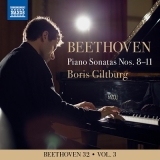 Ludwig van Beethoven: Klaviersonaten Vol. 3: Nr. 8 c-Moll op. 13 (Pathétique) + Nr. 9 in E-Dur, Op. 14/1 + Nr. 10 in G-Dur, Op. 14/2 + Nr. 11 in B-Dur op. 22; Boris Giltburg, Klavier; 1 CD Naxos 9.70309; Aufnahme 01/2020, Veröffentlichung 09/2020 (75'40) - Rezension von Remy Franck
Ludwig van Beethoven: Klaviersonaten Vol. 3: Nr. 8 c-Moll op. 13 (Pathétique) + Nr. 9 in E-Dur, Op. 14/1 + Nr. 10 in G-Dur, Op. 14/2 + Nr. 11 in B-Dur op. 22; Boris Giltburg, Klavier; 1 CD Naxos 9.70309; Aufnahme 01/2020, Veröffentlichung 09/2020 (75'40) - Rezension von Remy Franck
.
Was heißt ‘Pathétique’? Oft wird es von Pianisten mit ‘majestätisch’ und ‘kraftdonnernd’ übersetzt. Es gibt andere Deutungen. Plausibel scheint mir, was Boris Giltburg in Beethovens Achter Sonate macht. Sein erster Satz ist teils reflektiv, teils aufgewühlt, aber diese Beethoven-Musik klingt auch manchmal sehr verletzt. Entsprechend ist auch der zweite Satz alles andere als sorgenfreies Singen. Mit einem sehr persönlichen Akzentuieren und einer deutlichen Aufwertung der linken Hand bekommt der Satz ein neues Gesicht. Die Transparenz bestimmt auch den Klang des Rondos, das ungewöhnlich klar artikuliert wird. Eine phänomenale Vielfalt des musikalischen Diskurses ist das Resultat.
Ein Maximum an Expressivität gewinnt Giltburg auch den beiden Sonaten op. 14 ab. Das ist herzerfrischend! Er sieht sie als Gegenmittel zur Pathétique an, Sonaten, mit denen Beethoven nach der Pathétique seinen Geist mit klaren Tönen reinigen musste. Und genau so spielt er sie auch.
Die vernachlässigte 11. Sonate op. 22 erlangt bei Giltburg den Status der Grande Sonate, mit allem, was dazu gehört. Er spielt sie aufregend rhetorisch. Im Adagio verlangt Beethoven ‘con molto espressione’, und Giltburg nimmt diese Vorgabe sehr ernst. Er gibt dem Minuetto eine sehr vitale, tänzerische Leichtigkeit, nicht ohne etwas Grummeln einzufügen. Das Rondo erklingt mit reizvollen Charme.
Zum Klang der Giltburg-Interpretationen trägt sicherlich auch der hervorragende, bestens ausgewogene Fazioli-Flügel bei, der dem Pianisten einen so klaren und fein konturierten Klang erlaubt.
What does ‘Pathétique’ mean? It is often translated by pianists as ‘majestic’ and ‘powerful’. There are other interpretations. The one by Boris Giltburg seems plausible to me. His first movement is partly reflective, partly agitated, but the music sometimes sounds very hurt. Accordingly, the second movement is anything but carefree singing. With a very personal accentuation and a clear enhancement of the left hand, Giltburg shows news aspects of this music. The transparency also characterizes the Rondo, which is articulated with unusual clarity. The result is a phenomenal diversity of musical discourse.
Giltburg also gains a maximum of expressiveness from the two sonatas op. 14. That is heart-refreshing! He sees them as an antidote to the Pathétique, as sonatas with which Beethoven had to purify his mind. And that is exactly how he plays them.
With Giltburg’s exciting rhetoric the neglected 11th Sonata op. 22 reaches the status of a Grande Sonata. In the Adagio Beethoven requires ‘con molto espressione’, and Giltburg takes this demand very seriously. He gives the Minuetto a very vital, dancing lightness, not without adding a little grumbling. The Rondo has a lovely charm.
The excellent, perfectly balanced Fazioli grand piano certainly contributes to the sound of the Giltburg interpretations, allowing the pianist to achieve such a clear and finely contoured sound.
























